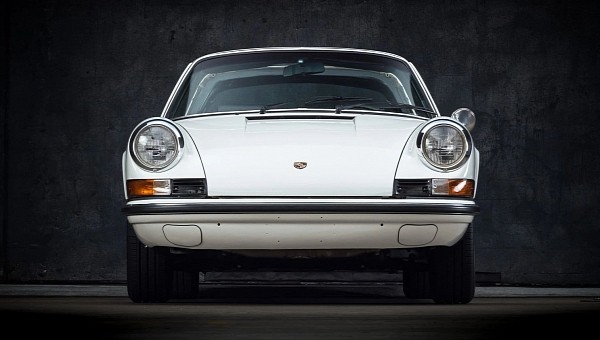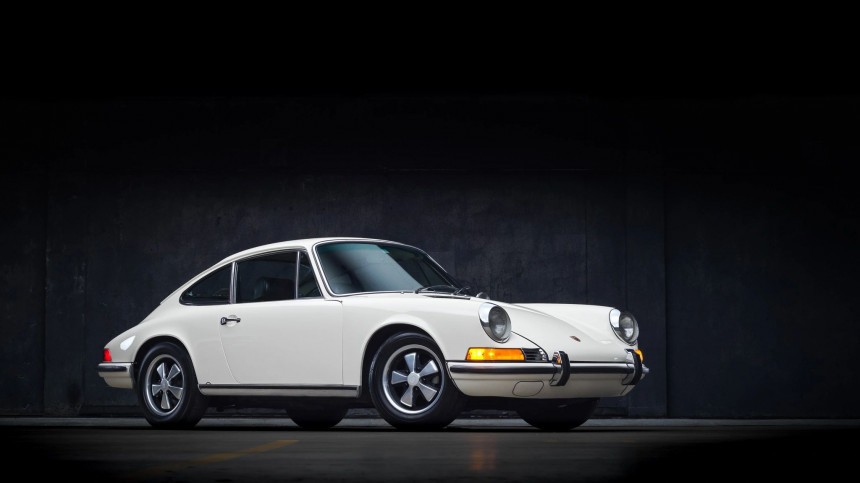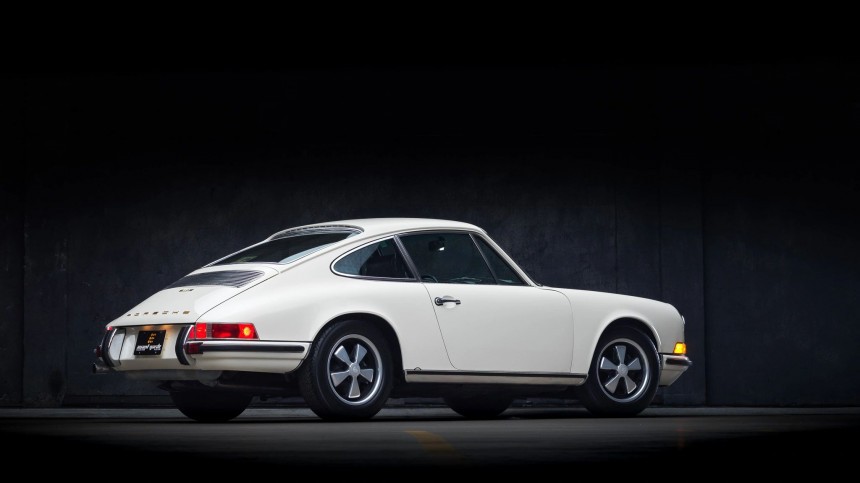The air-cooled Neunelfer rolled out in 1964 with the 2.0-liter O series. Having ended production in July 1967, the original was replaced by the more refined A series for the 1968 model year. Porsche further improved the breed with the B series for the 1969 model year, the most significant change being the slightly longer wheelbase that bettered the handling.
Porsche used 2.0-liter boxers for the O, A, and B. Direct and indirect competitors to the 911 had more displacement to offer, and the Stuttgart-based automaker knew that something had to change. Enter the C series, launched for the 1970 model year with a carbureted 2,195-cc powerplant.
Porsche started making the C-series 911 in August 1969, with production ending in July 1970 for the D series we’ll cover later on. Three specifications (T, E, and S) and two body styles (fixed-head coupe and targa) were offered. Just under 15,000 units of the C series were delivered, of which the 911 T Coupe was the most popular with 6,544 units to its name.
On the opposite side of the spectrum, Porsche finished 729 examples of the 911 S Targa for the 1970 model year. 204 cubic centimeters larger than its predecessor, the air-cooled engine in these vehicles had its bore increased from 80 to 84 millimeters. Stroke remained put at 66 millimeters. Codenamed Type 911 rather than 901 as was the case for previous 911s, this engine features beefier connecting rods, better cooling, redesigned gaskets, and bigger valves to produce that little bit more power and torque.
A four-speed manual for the T, a five-speed manual for the E and S, and the four-speed Sportomatic for the T and E were offered. The latter is a semi-automatic design developed in collaboration with Fichtel & Sachs, a four-speed unit featuring a torque converter and a vacuum-operated clutch. All C-series variants came with dry-sump lubrication, which is only natural given that a dry-sump layout allows the powerplant to be mounted lower, thus improving the center of gravity. It also works better in sustained cornering since it’s designed to never allow the engine to be starved of oil.
Type 911/03, the Euro-spec engine of the 911 T, boasts 125 metric horsepower (123 mechanical horsepower) at 5,800 revolutions per minute and 176 Nm (130 pound-foot) of torque at 4,200 revolutions per minute. The 911 T for the United States came with the 911/07 engine, yet the U.S.-market 911 E and 911 S shared their engines with their European siblings.
911/01 is the codenamed for the 911 E-spec boxer, which upped the compression ratio from the T’s 8.6:1 to 9.1:1. It also featured Bosch mechanical fuel injection rather than a pair of Zenith 40 TIN carbs. These changes improved output ratings to 155 ps (153 hp) at 6,200 revolutions per minute and 191 Nm (141 lb-ft) of torque at 4,500 revolutions per minute.
Last but certainly not least, the performance-oriented 911 S came with the 911/02 engine that upped the compression ratio to 9.8:1 while retaining the Bosch-supplied mechanical fuel injection of the 911 E. Even though the B-series 911 S was running a slightly higher compression ratio, the increase in displacement for the C resulted in 180 ps (178 hp) at 6,500 revolutions per minute and 199 Nm (147 pound-foot) at 5,200 revolutions per minute.
It should also be mentioned that Ts and Es with the Sportomatic featured different engine type numbers, namely 911/06 for the European T, 911/08 for the U.S. T, and 911/04 for both the E. Coated with Tectyl for anti-corrosion protection, the unitary steel chassis of the C-series 911 is complemented by independent suspension at every corner. The front axle features MacPherson struts with a lower wishbone, and the rear end rocks semi-trailing arms. The C series differs from the B in terms of front suspension, with Porsche relocating the mounting points slightly forward.
Steel rims and Fuchs alloys were standard issue, as were ventilated brake discs. The fuel tank can hold 62 liters of gasoline, which is 16.4 gallons. The 911 S could be optioned with a long-range tank. The Neunelfer's highly coveted C series further differs from the B through the plastic used for the ignition key handle compared to the preceding model’s all-metal key.
Although it was mainly made from steel, the C series also used aluminum for the engine lid. The German automaker had also improved the design of the door handles with an opening trigger behind the catch. In terms of extras, notable options include a radio, better shock absorbers supplied by Koni, an electric sunroof for the coupe, front-seat headrests, as well as a rear wiper.
The D-series 911 started production in August 1970 with minor improvements that didn’t bring any power bumps with them. The options list, for example, welcomed a heated windshield. The underbody was treated with a zinc coating, and engine cooling was improved with the introduction of crankcase squirters. Porsche further perfected the breed with a sealed chain tensioner, and the glovebox was updated with a twist-and-pull knob. Vehicles for the United States market came with an evaporative system.
A little over 10,000 examples of the D-series 911 were finished for the 1971 model year, with the 911 T Targa numbering 3,476 units. By comparison, the rarest configuration is the 911 S Targa at 788 units. For MY72, the Stuttgart-based automaker introduced the E series with a 2.4-liter engine.
Porsche started making the C-series 911 in August 1969, with production ending in July 1970 for the D series we’ll cover later on. Three specifications (T, E, and S) and two body styles (fixed-head coupe and targa) were offered. Just under 15,000 units of the C series were delivered, of which the 911 T Coupe was the most popular with 6,544 units to its name.
On the opposite side of the spectrum, Porsche finished 729 examples of the 911 S Targa for the 1970 model year. 204 cubic centimeters larger than its predecessor, the air-cooled engine in these vehicles had its bore increased from 80 to 84 millimeters. Stroke remained put at 66 millimeters. Codenamed Type 911 rather than 901 as was the case for previous 911s, this engine features beefier connecting rods, better cooling, redesigned gaskets, and bigger valves to produce that little bit more power and torque.
A four-speed manual for the T, a five-speed manual for the E and S, and the four-speed Sportomatic for the T and E were offered. The latter is a semi-automatic design developed in collaboration with Fichtel & Sachs, a four-speed unit featuring a torque converter and a vacuum-operated clutch. All C-series variants came with dry-sump lubrication, which is only natural given that a dry-sump layout allows the powerplant to be mounted lower, thus improving the center of gravity. It also works better in sustained cornering since it’s designed to never allow the engine to be starved of oil.
911/01 is the codenamed for the 911 E-spec boxer, which upped the compression ratio from the T’s 8.6:1 to 9.1:1. It also featured Bosch mechanical fuel injection rather than a pair of Zenith 40 TIN carbs. These changes improved output ratings to 155 ps (153 hp) at 6,200 revolutions per minute and 191 Nm (141 lb-ft) of torque at 4,500 revolutions per minute.
Last but certainly not least, the performance-oriented 911 S came with the 911/02 engine that upped the compression ratio to 9.8:1 while retaining the Bosch-supplied mechanical fuel injection of the 911 E. Even though the B-series 911 S was running a slightly higher compression ratio, the increase in displacement for the C resulted in 180 ps (178 hp) at 6,500 revolutions per minute and 199 Nm (147 pound-foot) at 5,200 revolutions per minute.
It should also be mentioned that Ts and Es with the Sportomatic featured different engine type numbers, namely 911/06 for the European T, 911/08 for the U.S. T, and 911/04 for both the E. Coated with Tectyl for anti-corrosion protection, the unitary steel chassis of the C-series 911 is complemented by independent suspension at every corner. The front axle features MacPherson struts with a lower wishbone, and the rear end rocks semi-trailing arms. The C series differs from the B in terms of front suspension, with Porsche relocating the mounting points slightly forward.
Although it was mainly made from steel, the C series also used aluminum for the engine lid. The German automaker had also improved the design of the door handles with an opening trigger behind the catch. In terms of extras, notable options include a radio, better shock absorbers supplied by Koni, an electric sunroof for the coupe, front-seat headrests, as well as a rear wiper.
The D-series 911 started production in August 1970 with minor improvements that didn’t bring any power bumps with them. The options list, for example, welcomed a heated windshield. The underbody was treated with a zinc coating, and engine cooling was improved with the introduction of crankcase squirters. Porsche further perfected the breed with a sealed chain tensioner, and the glovebox was updated with a twist-and-pull knob. Vehicles for the United States market came with an evaporative system.
A little over 10,000 examples of the D-series 911 were finished for the 1971 model year, with the 911 T Targa numbering 3,476 units. By comparison, the rarest configuration is the 911 S Targa at 788 units. For MY72, the Stuttgart-based automaker introduced the E series with a 2.4-liter engine.






































































